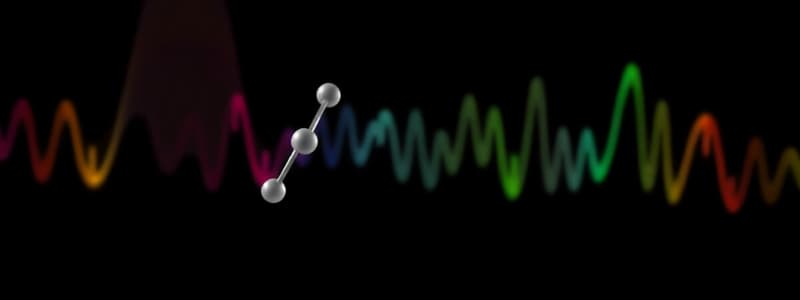Podcast
Questions and Answers
What does a molecule's symmetry indicate in NMR spectroscopy?
What does a molecule's symmetry indicate in NMR spectroscopy?
- No protons or carbons are observed
- Different chemical shifts for all protons and carbons
- Only one signal appears for the entire molecule
- Protons and carbons can be observed at the same chemical shift (correct)
A molecule with an Index of Hydrogen Deficiency of 0 has no rings or multiple bonds.
A molecule with an Index of Hydrogen Deficiency of 0 has no rings or multiple bonds.
True (A)
What is the Index of Hydrogen Deficiency (IHD) for the molecular formula C5H12O?
What is the Index of Hydrogen Deficiency (IHD) for the molecular formula C5H12O?
0
In NMR, the number of _____ signals corresponds to the number of unique types of protons in a molecule.
In NMR, the number of _____ signals corresponds to the number of unique types of protons in a molecule.
Match the integration values to the corresponding chemical structures in the molecule C5H12O:
Match the integration values to the corresponding chemical structures in the molecule C5H12O:
Why does tert-butyl acetate (C6H12O2) exhibit two signals in its 1H-NMR spectrum?
Why does tert-butyl acetate (C6H12O2) exhibit two signals in its 1H-NMR spectrum?
Chemical shifts in an NMR spectrum can vary based on the functional groups present in a molecule.
Chemical shifts in an NMR spectrum can vary based on the functional groups present in a molecule.
What substructures do the signals correspond to in the molecule C5H12O?
What substructures do the signals correspond to in the molecule C5H12O?
What does the IHD value indicate about a molecule's structure?
What does the IHD value indicate about a molecule's structure?
The m/z value in mass spectrometry directly corresponds to the molecular mass for ions with z = 2.
The m/z value in mass spectrometry directly corresponds to the molecular mass for ions with z = 2.
What is the chemical shift common for the O−H functional group in NMR spectroscopy?
What is the chemical shift common for the O−H functional group in NMR spectroscopy?
In 1H-NMR, the ____ indicates how many hydrogens are equivalent within a chemical environment.
In 1H-NMR, the ____ indicates how many hydrogens are equivalent within a chemical environment.
Match the NMR signal characteristics with their explanations:
Match the NMR signal characteristics with their explanations:
Which is a characteristic of 13C-NMR compared to 1H-NMR?
Which is a characteristic of 13C-NMR compared to 1H-NMR?
High-resolution mass spectrometry cannot distinguish between compounds with similar m/z values.
High-resolution mass spectrometry cannot distinguish between compounds with similar m/z values.
What information does NMR provide regarding functional groups?
What information does NMR provide regarding functional groups?
Which functional group is likely to appear at a higher chemical shift in NMR spectra?
Which functional group is likely to appear at a higher chemical shift in NMR spectra?
Vinylic protons typically resonate at lower chemical shifts compared to saturated protons.
Vinylic protons typically resonate at lower chemical shifts compared to saturated protons.
What does the term 'chemical shift' in NMR refer to?
What does the term 'chemical shift' in NMR refer to?
In 1H-NMR spectroscopy, the presence of an _____ signal indicates a protons in an aromatic system.
In 1H-NMR spectroscopy, the presence of an _____ signal indicates a protons in an aromatic system.
Match the following signals with their corresponding types of protons in NMR spectra:
Match the following signals with their corresponding types of protons in NMR spectra:
Which of the following statements about 13C-NMR is true?
Which of the following statements about 13C-NMR is true?
The integration of NMR signals provides information on the number of equivalent protons.
The integration of NMR signals provides information on the number of equivalent protons.
What can be inferred if two sets of signals in the NMR spectrum are equivalent?
What can be inferred if two sets of signals in the NMR spectrum are equivalent?
Chemical shifts in NMR are measured in _____ units.
Chemical shifts in NMR are measured in _____ units.
In the context of NMR, what is a local field effect?
In the context of NMR, what is a local field effect?
Flashcards are hidden until you start studying
Study Notes
Symmetry and NMR
- Symmetry in molecules can lead to protons and carbons being observed at the same chemical shift in NMR spectra.
- The number of symmetry axes in a molecule affects the number of NMR signals observed.
- The integration of signals in the 1H-NMR spectrum corresponds to the relative number of protons in each environment.
Functional Groups and NMR
- 1H-NMR: Chemical shift can indicate the type of functional group present.
- Vinylic protons (adjacent to double bond) appear around 5.5 ppm.
- Allylic protons (two carbons away from double bond) appear around 3.4 ppm.
- Saturated protons appear around 0 ppm.
- Aromatic protons appear around 7 ppm.
- Protons attached to electronegative atoms (e.g., halogens) appear at higher chemical shifts.
- 13C-NMR: Chemical shift can also indicate the type of functional group present.
- Carbonyls appear around 210 ppm.
- Aromatics appear between 120-150 ppm.
- Vinylic carbons appear around 130 ppm.
- Allylic carbons appear around 40 ppm.
- Saturated carbons appear around 0 ppm.
- Increasing electron density near the proton or carbon shifts the signal to a higher chemical shift.
Electron Impact Ionisation (EI) Mass Spectrometry
- EI-MS involves bombarding molecules with electrons to create ions.
- The molecular ion (M+) is the most intense signal and its m/z value corresponds to the molecular mass.
- High-resolution MS can differentiate between compounds with similar masses.
IR Spectroscopy
- IR spectroscopy measures the vibrational and rotational energy levels of molecules.
- The frequency of absorbed radiation indicates the presence of specific functional groups.
- Particularly useful for identifying carbonyl (C=O) and alcohol (O-H) groups.
Index of Hydrogen Deficiency (IHD)
- IHD is a measure of the number of rings and/or pi bonds in a molecule.
- For a given molecular formula, the IHD can be used to predict possible structures.
- The higher the IHD, the more degrees of unsaturation are present.
NMR Fundamentals
- Atoms with spin ≠ 0 are NMR active.
- 1H and 13C have a spin = ½ (I = ½) and 2I + 1 orientations in a magnetic field.
- A radio-frequency pulse flips the spin to the higher energy state, which is detected.
- The chemical shift is influenced by both the type of atom and the strength of the magnetic field.
Studying That Suits You
Use AI to generate personalized quizzes and flashcards to suit your learning preferences.


